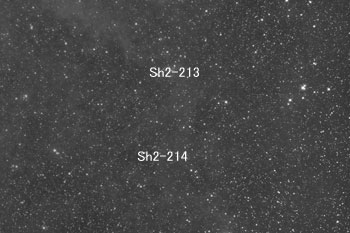| Date & Time: | Nov 1 2025, from 25:53 to 27:05 JST(+0900) |
| Composed 10 shots with 8 minutes exposed |
| Optical: | TAKAHASHI 16cm(6.3") epsilon (f=530mm, F3.3) |
| with IDAS LPS-D1 light-pollution suppression filter |
| Auto-guided with TAKAHASHI JP Equatorial+SBIG STV |
| CMOS Camera: | ZWO ASI2600MC Pro (Cooled temp.: -15°C) |
| Location: | Ooizumi, Hokuto city, Yamanashi pref. |
| Sh2-213 / Diffused Nebula, type 6 E+R |
|---|
| R.A. | 04h 20m 43.2s (2000.0) |
|---|
| Dec. | +44°56' 26" (2000.0) |
|---|
| Apparent Size | 1.0×1.0' |
|---|
| Real Size | 2 light yrs./A |
|---|
| Magnitude | - |
|---|
| Distance | 6850 light yrs. |
|---|
| Other IDs | LBN 731 |
|---|
|
| Sh2-214 / Molecular Cloud, type 6 R |
|---|
| R.A. | 04h 21m 30.0s (2000.0) |
|---|
| Dec. | +44°22' 00" (2000.0) |
|---|
| Apparent Size | 4.0×4.0' |
|---|
| Real Size | 0.75 light yrs. |
|---|
| Magnitude | - |
|---|
| Distance | 650 light yrs. |
|---|
|
This image captures a faint molecular cloud spread across the northeastern region of Perseus, corresponding to the western edge of the Milky Way, in an area located just under 10 degrees west of Capella in Auriga.
The slightly reddish Hα region visible near the top of the image is Sh2-213, overlapping with the extremely faint open cluster Berkeley 11.
The nebula itself is only about 1 arcminute in size, and its distance is estimated to be roughly 6,800 light-years.
The image also shows a veil-like molecular cloud covering almost the entire field, with the lower portion designated as Sh2-214.
Although its cataloged size is 4 arcminutes, this image reveals that it actually extends over more than 30 arcminutes.
The distance to this molecular cloud is estimated-though with considerable uncertainty-to be about 650 light-years, meaning that Sh2-213 lies more than ten times farther away.
|



